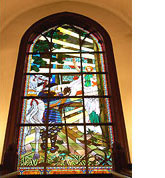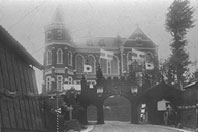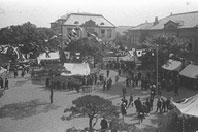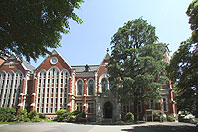The Old University Library and the Stained Glass Passed Down Through the Ages
The Mita Campus Old University Library was built to commemorate the 50th Anniversary of Keio. To the right of the entrance grows a mighty Himalayan cedar, and to the left there is a bust of Yukichi Fukuzawa watching over Keio students. In the central stairwell of this building that breathes history, a magnificent stained glass window radiates—an artist's masterpiece, restored by the devotion of his pupil.

In the Final Days of the Meiji Era, the Library's Opening Ceremony Saw the Whole of Mita in a Celebratory Mood


1907 was the year that Keio celebrated the 50th Anniversary of its founding. As a commemorative project, a library was constructed which was completed on April 15, 1912. The next day it was open to students, but the opening ceremony came on May 18. More than 800 visitors came out on the fine day, as shops lining Mita-dori were flying Keio flags out front, and a celebratory mood permeated the Mita neighborhood at the completion of the beautiful red-brick, Gothic-style library.
The visitors to the library were captivated by the splendid and graceful building, but three years later, in December 1915, there was a beautiful addition to the building that pleased the eyes of all who visited: a huge stained glass window measuring 6.45 meters high and 2.61 meters wide in the central stairwell.
The original design was by the Western-style painter Eisaku Wada. The composition shows a warrior in a suit of armor—symbolizing feudal militarism—dismounting his horse to welcome a goddess, symbolizing Western civilization. She is holding the Keio pen-mark in one hand and emerges from a gate along with a flood of radiant light. It perfectly encapsulates the spirit of Keio opening up to a new era. In the lower portion are the Latin words Calamvs Gladio Fortior (The pen is mightier than the sword), and on either side in Roman numerals are the year of the founding of Keio (1858) and the year of the 50th Anniversary (1907).
The stained-glass artist who carried out the construction of the window from the original design was Sanchi Ogawa. Ogawa, just back from the U.S.A. after training in the art of stained glass, ordered glass from the States and labored long and hard, even layering the glass two or three times for a deep color. It received great praise as "an outstanding achievement by the hand of a Japanese artist."
The Library Falls Victim to the 1945 Tokyo Air Raids, the Stained Glass is Also Lost
On the evening of May 25, 1945, the library was struck by air raids, and while the library collection mostly escaped harm, the intensity of the firebombs caused the entire building—including the octagonal tower—to be engulfed by flames, and the stained glass window was also lost.
All those related to Keio grieved at the pitiful sight of the charred remains. Professor Emeritus Shigetomo Koda wrote: "It is somehow so tragic to see from down on Mita-dori the burnt top floor of the library, suspended in the air." (In the August 1946 edition of Bungeishunju)
Also, in the February 1947 edition of Mita Newspaper, Shinobu Orikuchi, a Professor in the Faculty of Letters, composed the following poem lamenting the burning down of the Library:
Above the ashes rising high toward the skies is the bare library roof
Exposing its steel frame like a dragon's fins and below, the rugged
soot-stained bricks and ancient-like rocks
Is it the building we once knew? No, it cannot be.
Many of the school buildings were lost in the ravages of war, and since the Hiyoshi Campus was requisitioned by the U.S. Army, Keio was in a rush to repair the damaged buildings. The reconstruction of the library took several years, and the reopening ceremony was held on May 5, 1949. However, the large window where the stained glass once was simply had a clear glass installed.
For those that knew the library before the war, a library without the stained glass window was somehow incomplete and evoked a tinge of loneliness. For Ryuzo Ohtake, who had studied the art of stained glass under Sanchi Ogawa and was actively working in the field, it was too much to bear for his master's representative work to be gone forever. At the time the stained glass window was originally being made, Ohtake was merely an errand boy and actually had no hand in creating the work. However, this stained glass window by his master whom he looked up to during his training as a youth, was a truly precious work to him. Overcome with the thought that he must do something, he resolved to restore the window in 1971. He was already at the ripe age of 77.
Ryuzo Ohtake's Final Calling: Reviving the Library's Stained Glass Window

Over the years, the colors in the original design by Wada had faded, and there was no color photograph of the stained glass window in existence. Reproducing the original color was a huge problem. However, Ohtake ordered the glass from the same American company where his master Ogawa ordered it from, and he immersed himself in the delicate and painstaking task of the restoration.
"To my father, this work—which rather than 'restoration' should be called a 'revival'—meant two things. One, it was above all an announcement to his master Sanchi Ogawa about the revival of the stained glass, and the other was a culmination of the path he had walked over his lifetime." (Written by his son and successor, Katsuya Ohtake, in Mita-hyoron Jan 1975)
Then, when the three-year project was nearing an end, on the 10th of October, 1974, the day after he gave instructions on the final color adjustments to an assistant, Ohtake suddenly passed away. The unveiling ceremony was held on the two-month anniversary of his death, on December 10th. The restored stained glass window of the library was a fruit of Ohtake's devotion—and a brilliant one.
When you enter through Keio's East Gate and ascend the stairs, there on your right is the elegant Old University Library, still radiating the colors of days past. For Keio students of today, and alumni who studied at Mita during their youth, the sight of the Old University Library is a symbol that carries the intellectual dignity befitting Keio. And inside the building's central stairwell, the stained glass window made by the master Sanchi Ogawa and restored by his pupil Ryuzo Ohtake, has transcended time and still wonderfully portrays the wisdom that the pen is mightier than the sword.
